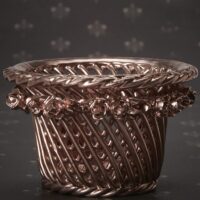It’s always interesting to take a look at weapons from the past and see how they would have worked back in the day. While a lot of them fall under the categories of stabbing weapons, clubbed weapons, slashing weapons, and other weapons with macabre adjectives, quite a number have weird designs that aren’t so well-known to most of us.
Take for example the “swordbreaker” – a parrying dagger made during the late European Middle Ages to the early Renaissance. Its main purpose is to catch an opponent’s blades and prevent the person from properly using them.

Tod Cutler from Tod’s Workshop has crafted his own sword breaker and takes a look at what makes this dagger tick. From its overall design to practical use, he discovers why the swordbreaker was made – and why you ultimately don’t see it as often as other ancient weapons.

From the outset, Tod mentions the swordbreaker is meant to be held in your non-dominant hand. Seeing as most people are right-handed, this means the swordbreaker was usually forged to be a left-handed weapon.
What’s interesting about this is that when you fit your left thumb through the thumb ring of the weapon, the orientation of the sword breaker changes in such a way that the blade side is facing upwards, leaving the iconic tines facing down.
This means the swordbreaker was not meant to create direct damage, but rather to catch an opponent’s blade in between the tines. By holding the dagger with the blade facing your face, you can angle the tines towards an enemy’s sword strike, and catch their blade.

Once the blade is in the swordbreaker’s grasp, the wielder is free to control his opponent’s blade as he wishes. You can pull, twist, and even push the blade in whichever direction you want as long as the sword is stuck between the tines. The only way your opponent can free his weapon is if you allow him to pull the sword away from the swordbreaker at the same angle he would be attacking you in.
Despite its name, Tod mentions that the swordbreaker does not have much power when it comes to destroying swords. The metal in most swords is way thicker than the swordbreaker itself, and you would need to exert a lot of force to be able to bend, much less break, a well-forged sword.

This brings us to why you don’t see a lot of the swordbreaker nowadays. Apart from the misleading name, it must have been a nightmare to create these parrying daggers. Forging the tines is very difficult, as you have to make sure the space between them is enough to fit a typical sword while ensuring the grooves can keep the weapon in place once caught.
There are also different ways of forging a swordbreaker found throughout history. Back in those times, tines were filed, punched, and even fitted with pivots to allow the dagger to better hold a sword.

Lastly, the main reason the swordbreaker isn’t as commonplace as other ancient weapons is because it doesn’t work all the time. You have to be really accurate and really lucky to get this parrying dagger to work. Not only you have to angle the tines in the way of your opponent’s blade, but you also have to hope the blade falls into the small spaces between the swordbreaker and gets caught.
Those are a lot of elements you have to factor in for the swordbreaker to work; with the big downside being that if you miss, you’re a sitting duck. Without a second weapon to block your left side (you’re going to be instinctively using your sword to watch your right flank), you’re leaving yourself wide open for a counterattack. Needless to say, the idea of catching swords with daggers doesn’t really catch on as shields are proved more reliable in the long run.
Tod recreates a bunch of old school weapons and showcases them on his YouTube channel. If you’re feeling up for a duel, you can even find some of his works for sale on his website and Tod’s Workshop.




![6 Types of Civil Engineering Drawings [Detailed Guide]](https://www.solidsmack.com/wp-content/uploads/2023/12/Civil-Engineering-Drawings-270x180.jpeg)

